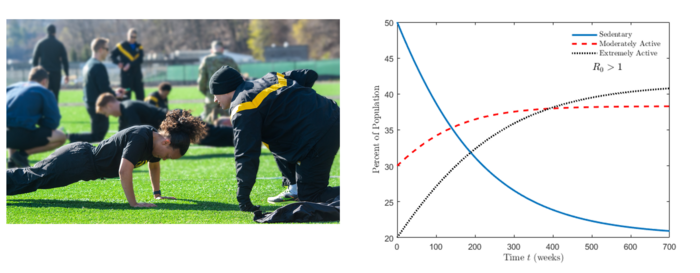A newly developed mathematical model incorporates the influence of social interactions on community exercise trends, suggesting that interacting with moderately active people could influence sedentary people to become more active. Ensela Mema of Kean University in Union, New Jersey, and colleagues present these findings in the open-access journal PLOS ONE on October 19, 2022.

Credit: James Straka, CC-BY 4.0 (https://creativecommons.org/licenses/by/4.0/)
A newly developed mathematical model incorporates the influence of social interactions on community exercise trends, suggesting that interacting with moderately active people could influence sedentary people to become more active. Ensela Mema of Kean University in Union, New Jersey, and colleagues present these findings in the open-access journal PLOS ONE on October 19, 2022.
In 2018, the U.S. Department of Health and Human Services published evidence-based guidelines outlining recommended types and amounts of physical activity to promote health benefits for different populations of Americans. However, national population-level trends suggest that there has been little improvement in meeting these recommendations.
To help address this issue, Mema and colleagues drew on previous research showing that social interactions with peers can play a key role in boosting physical activity within a community. In line with that knowledge, they developed a mathematical model that simulates how social interactions can affect a population’s exercise trends over time. The model incorporates data from the U.S. Military Academy.
The model simulations showed that, in the absence of social interactions, populations experienced a long-term decrease in physically active individuals, and sedentary behavior began to dominate. However, when the simulations included social interactions between sedentary and moderately active people, sedentary populations became more physically active in the long term. Still, in simulations where moderately active people became more sedentary over time, overall physical activity trends plummeted.
While these simulations were not validated with real-world data, the researchers say they provide new insights that could inform public health efforts to boost community physical activity levels. The researchers outline a number of recommendations for such efforts, such as social activities designed to boost interactions between sedentary and moderately active people.
These simulations could also inform efforts to maintain physical fitness in the U.S. military, the researchers note. However, they say, more research will be needed to better understand the balance between encouraging exercise among sedentary people while retaining activity levels in moderately active people.
The authors add: “We have traditionally directed physical activity interventions by engaging sedentary individuals to become more active. Our model suggests that focusing on the moderately active population to sustain their activity and increasing their interactions with sedentary people could stimulate higher levels of overall physical activity in the population.”
#####
In your coverage please use this URL to provide access to the freely available article in PLOS ONE: https://journals.plos.org/plosone/article?id=10.1371/journal.pone.0274259
Citation: Mema E, Spain ES, Martin CK, Hill JO, Sayer RD, McInvale HD, et al. (2022) Social influences on physical activity for establishing criteria leading to exercise persistence. PLoS ONE 17(10): e0274259. https://doi.org/10.1371/journal.pone.0274259
Author Countries: USA
Funding: DMT was funded by the National Institutes of Health Grant Number U54TR004279. JOH and DS were funded by the National Institutes of Health Grant Number P30DK056336 CKM was funded by the National Institutes of Health awards: P30DK072476, U54 GM104940 ADB was funded by the National Institutes of Health awards, OT2OD026552, UG1HD107711, U19AI14418, UO1 CA196406 The funders had no role in study design, data collection and analysis, decision to publish, or preparation of the manuscript.
Journal
PLoS ONE
DOI
10.1371/journal.pone.0274259
Method of Research
Computational simulation/modeling
Subject of Research
Not applicable
Article Title
Social influences on physical activity for establishing criteria leading to exercise persistence
Article Publication Date
19-Oct-2022
COI Statement
The authors have declared that no competing interests exist.




